


The article titled "10 Essential Insights on Medical Device Class 3 Compliance" addresses the critical aspects of compliance for Class 3 medical devices, underscoring the rigorous regulatory requirements and the significance of comprehending the Premarket Approval (PMA) process. It asserts that manufacturers must adeptly navigate complex regulations, which include extensive clinical data requirements and post-market surveillance, to guarantee the safety and efficacy of these high-risk devices—devices that constitute a substantial share of the medical device market.
The landscape of medical devices is increasingly complex, particularly for Class III products that carry the highest risk and regulatory scrutiny. Understanding the nuances of compliance in this realm is not just beneficial; it is essential for manufacturers, healthcare providers, and regulators alike. This article delves into ten critical insights surrounding Class III medical device compliance, illuminating the pathways to successfully navigating the stringent regulatory environment. It highlights the pivotal role of clinical trials and the innovative technologies shaping the future of healthcare.
What challenges do stakeholders face in ensuring compliance?
How can they leverage these insights to enhance patient safety and advance medical technology?
bioaccess® excels in early-phase clinical studies for Category III health products, leveraging its regulatory agility and diverse patient populations across Latin America, the Balkans, and Australia. This strategic approach enables ethical approvals in an impressive 4-6 weeks, significantly faster than the average FDA 510(k) decision time of approximately five months. By streamlining processes and ensuring compliance with local regulations, bioaccess® empowers Medtech innovators to achieve enrollment rates that are 50% faster than traditional markets, enhancing the likelihood of successful clinical outcomes.
The organization’s dedication to regulatory flexibility underscores the importance of operational efficiencies in the clinical trial arena, establishing it as an essential partner for companies navigating the complexities of developing medical device class 3 products. With the healthcare market in Latin America estimated at approximately $29 billion, the benefits of early-phase clinical studies become increasingly evident. This approach provides a pathway for innovative technologies to reach patients more swiftly, reinforcing the critical role of collaboration in advancing healthcare solutions.
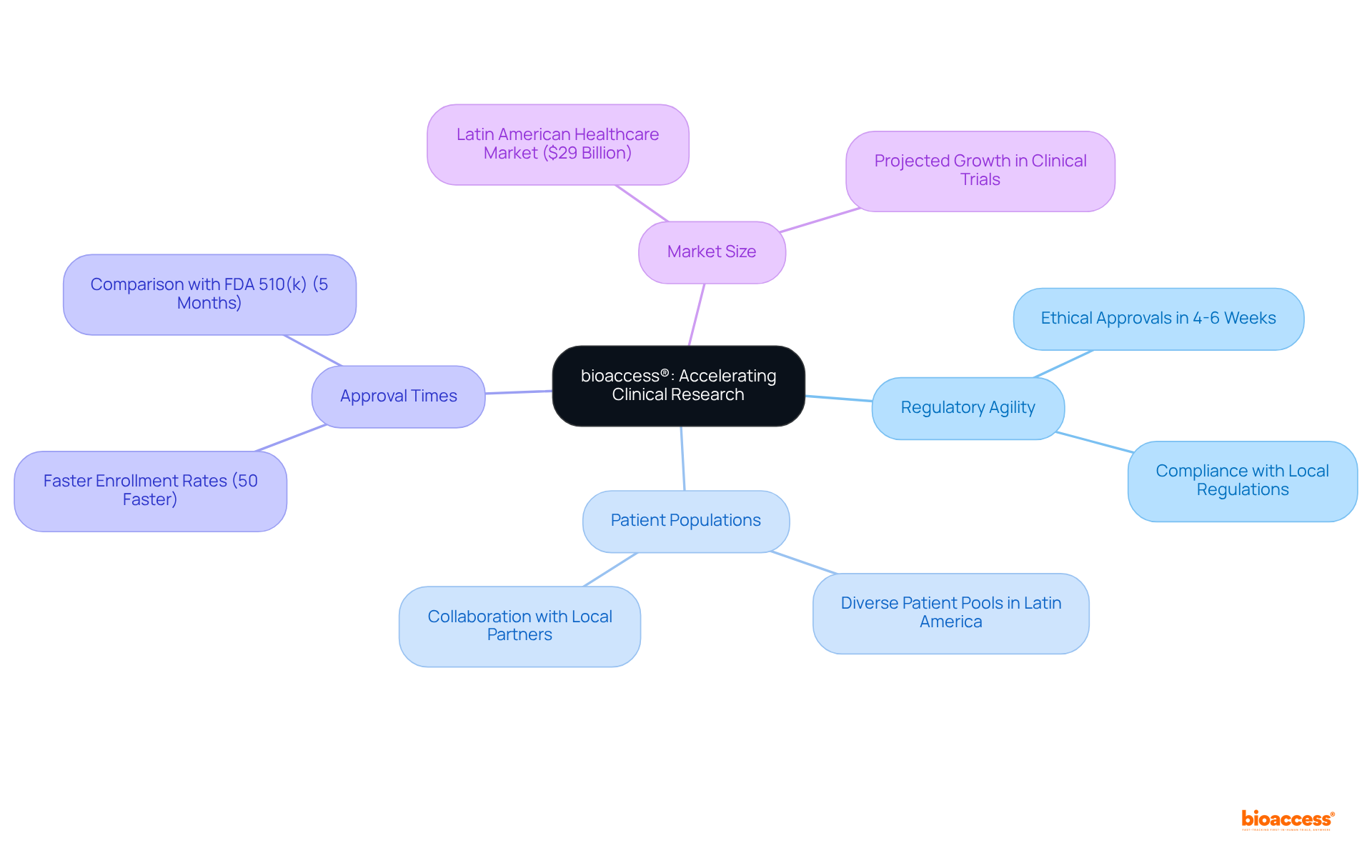
Medical device class 3 instruments are subject to the most stringent regulatory requirements due to their potential risks to patients. Manufacturers must comply with the FDA's Premarket Approval (PMA) process, which necessitates comprehensive clinical data that demonstrates both safety and efficacy. The average expenditure for PMA applications reaches approximately $94 million, significantly higher than the $31 million required for the less stringent 510(k) process. Furthermore, equipment must satisfy general controls and particular performance standards. Understanding these regulations is essential for ensuring that a medical device class 3 is safe for public use and can effectively navigate the approval process.
Recent updates indicate that while the FDA aims for a six-month review period for PMA applications, actual decision times have historically exceeded this target, averaging 432 days in 2013. Despite these challenges, the PMA process boasts a high approval rate, with nearly every application accepted in recent years being granted approval. However, compliance rates reveal that 15 percent of 510(k) submissions did not receive a Substantially Equivalent decision, underscoring the complexities involved.
Real-world examples illustrate the implications of these regulations. For instance, medical device class 3 products that receive PMA approval benefit from a legal standard known as preemption, which restricts lawsuits associated with these items, thereby encouraging manufacturers to pursue PMA despite the higher costs. Conversely, products approved via the 510(k) process are more exposed to legal action, emphasizing the strategic factors producers must consider when choosing their regulatory route.
Critics argue that the PMA process often involves testing on a small number of patients over a short period, which may not adequately represent diverse populations. Grasping these rules is essential for ensuring that medical device class 3 products are secure for public use and can effectively maneuver through the approval process, ultimately aiding their prompt introduction into the market.
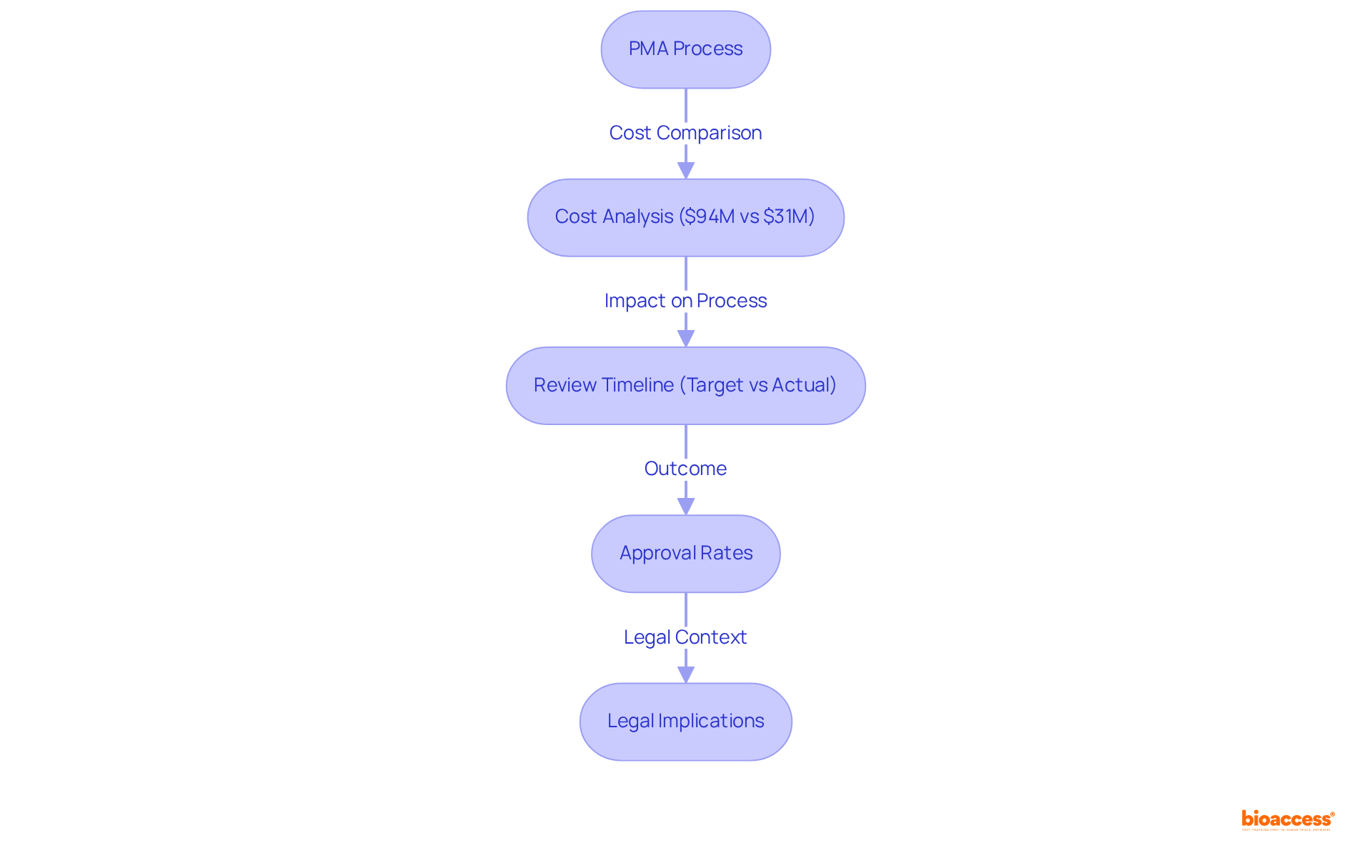
The Premarket Approval (PMA) process for medical device class 3 instruments represents a rigorous pathway, encompassing several essential steps:
Each of these steps is vital for demonstrating that the product meets stringent safety and effectiveness standards prior to market introduction. Notably, successful clinical trials for medical device class 3 instruments have exhibited varying success rates, with oncology trials historically achieving a mere 3.4% success rate, underscoring the challenges inherent to this high-risk category.
Furthermore, expert insights emphasize the necessity of robust preclinical studies, as they lay the groundwork for successful PMA submissions, ultimately facilitating timely access to innovative medical technologies. Additionally, 43% of pilot studies have shown equivalent or improved successful screening probabilities compared to larger counterparts, reinforcing the effectiveness of these preliminary studies.
The oncology trial success rate has also seen significant advancement, increasing from 1.7% in 2012 to 2.5% in 2014 and 8.3% in 2015, highlighting the evolving landscape of clinical trials for medical device class 3 products. Moreover, Investigational Device Exemptions (IDEs) are crucial for medical device class 3 instruments, as they allow for the collection of clinical data necessary for PMA submissions.
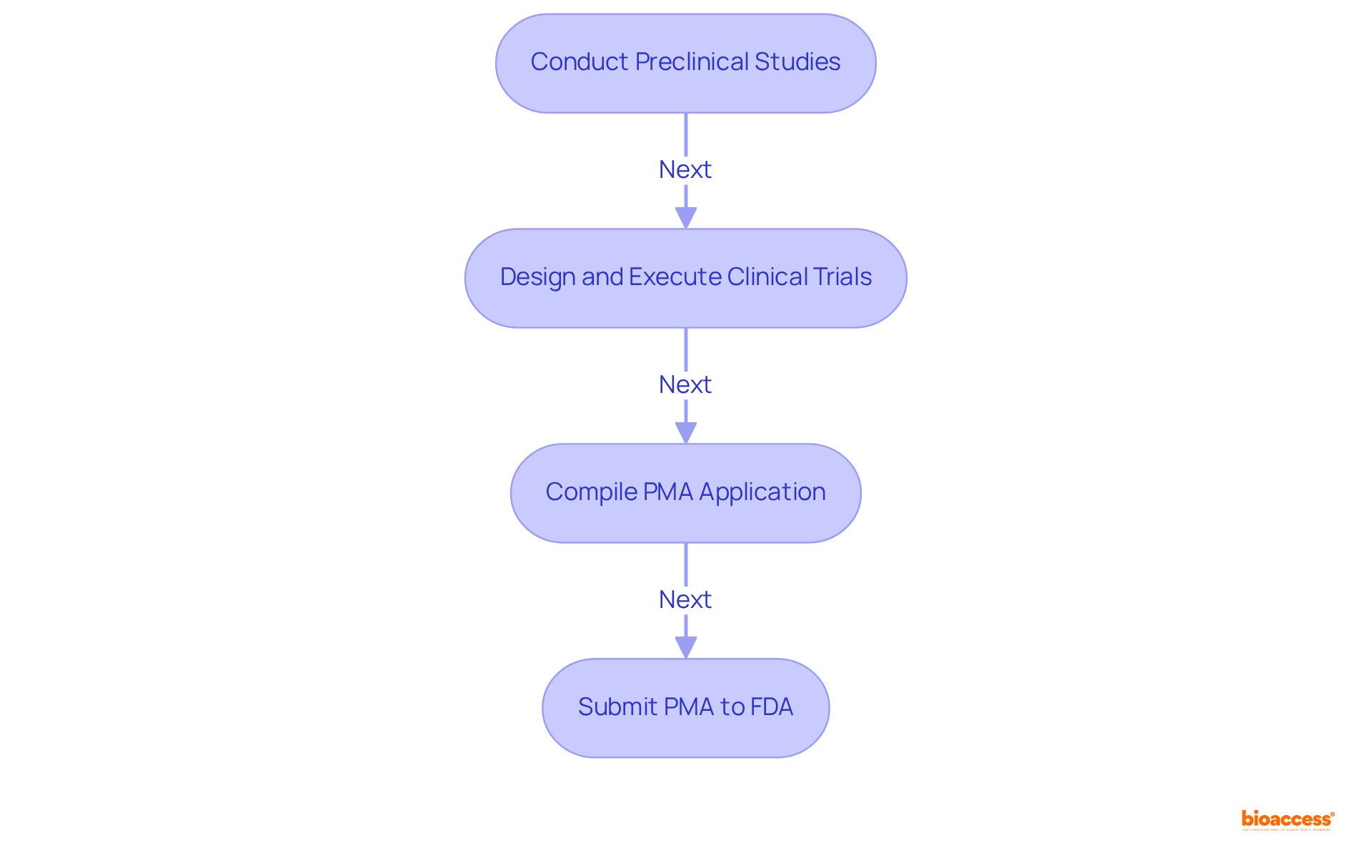
Medical instruments that fall under the medical device class 3 category, classified as high-risk, are subjected to the most rigorous regulatory controls, including the Premarket Approval (PMA) process. This process stands as the most intensive type of marketing application mandated by the FDA, requiring comprehensive clinical study results to substantiate safety and effectiveness.
In contrast:
Notably, Category I healthcare instruments account for 35% of regulated items, providing context for the distribution of types.
Understanding this classification system is crucial for determining the appropriate regulatory pathway and ensuring patient safety. For instance, only 9% of authorized medical device class 3 fall into the III category, underscoring the stringent examination these items undergo. Real-world examples, such as cardiac pacemakers, breast implants, defibrillators, and high-frequency ventilators, illustrate the high-risk nature of medical device class 3 products and the extensive regulatory requirements they must fulfill.
Experts emphasize the importance of aligning human factors engineering (HFE) efforts with the equipment's risk classification to enhance usability and safety. Julee Henry, a Lead Human Factors Specialist, notes that considering the risk-based classification of healthcare products is essential for a successful regulatory submission. This alignment is vital for manufacturers navigating the complex landscape of health product regulations, ensuring compliance and enabling successful market entry.
Furthermore, the FDA organizes healthcare equipment classifications into 16 specialized panels, which further shapes the regulatory pathways for various types of equipment.
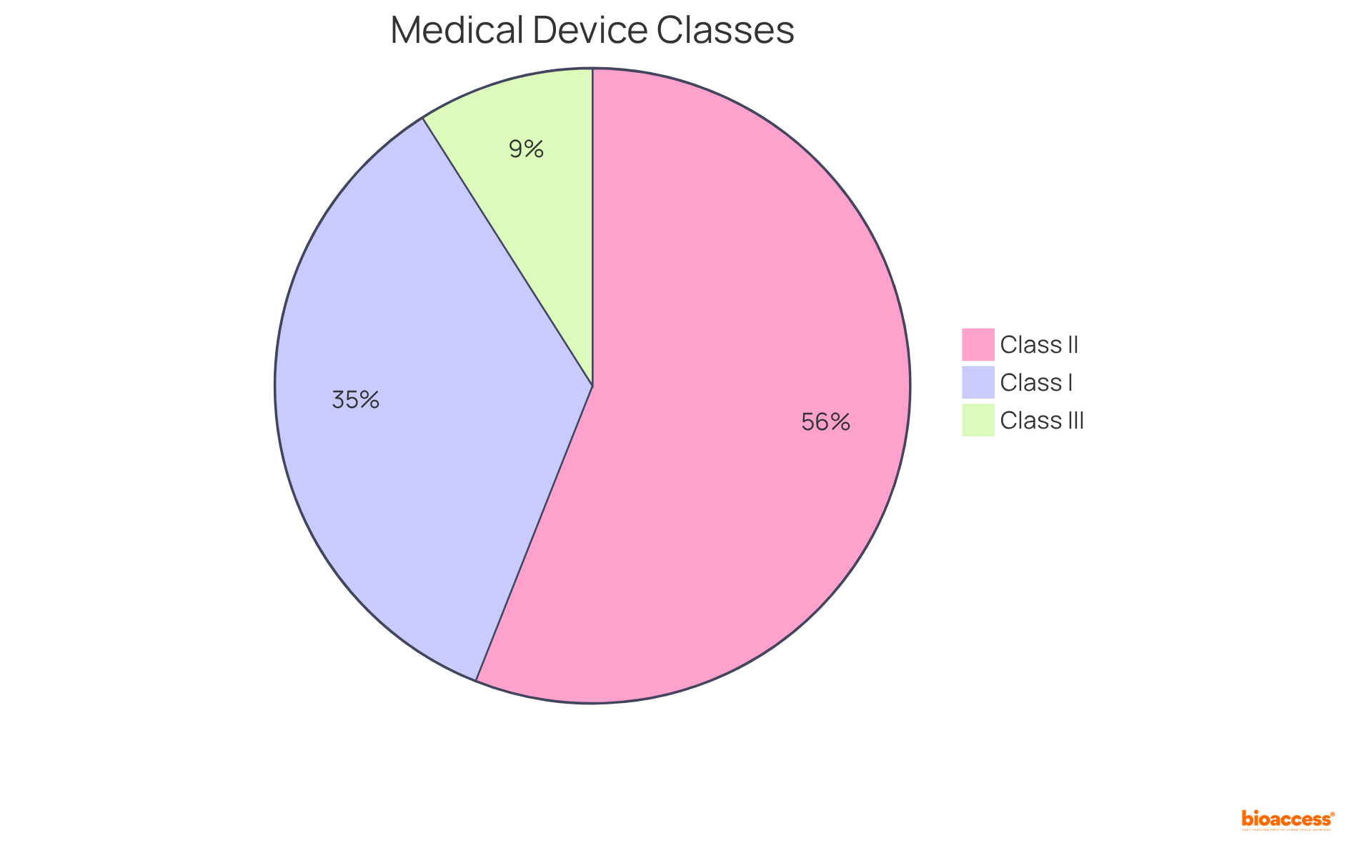
Medical device class 3 includes a range of critical health products, such as implantable pacemakers, defibrillators, cochlear implants, and heart valves. These tools play an essential role in preserving life and addressing severe health issues, with their creation and authorization being pivotal for advancing medical technology. The global cardiac rhythm management (CRM) market, which includes pacemakers and defibrillators, was valued at approximately USD 17.17 billion in 2024 and is projected to expand significantly, reaching USD 28.5 billion by 2033, indicating a compound annual growth rate (CAGR) of 5.79%. This growth underscores the increasing reliance on such tools for effective patient care, influenced partly by the rising incidence of cardiovascular diseases, a major health concern worldwide.
In practical applications, cochlear implants have transformed the lives of individuals with hearing loss, enabling them to perceive sound and communicate effectively. Similarly, heart valves—particularly transcatheter aortic valves—have revolutionized treatment for patients with aortic stenosis, facilitating minimally invasive procedures that enhance recovery times and reduce hospital stays.
Healthcare professionals emphasize the significant impact of these implantable technologies on patient outcomes. For instance, advancements in CRM tools have led to improved management of arrhythmias, markedly decreasing the risk of sudden cardiac death. As noted by a member of the Life Sciences Consulting Team at Acuity Knowledge Partners, "The incorporation of AI technologies in these tools enhances diagnostic precision and treatment customization, establishing new standards in patient care."
However, the market for medical device class 3 products faces challenges, including high costs and regulatory barriers that can hinder access and innovation. As the demand for medical device class 3 continues to rise, their role in improving health outcomes and quality of life remains vital. To navigate these challenges, stakeholders must focus on innovative solutions and strategic collaborations that can enhance the development and accessibility of these life-saving technologies.
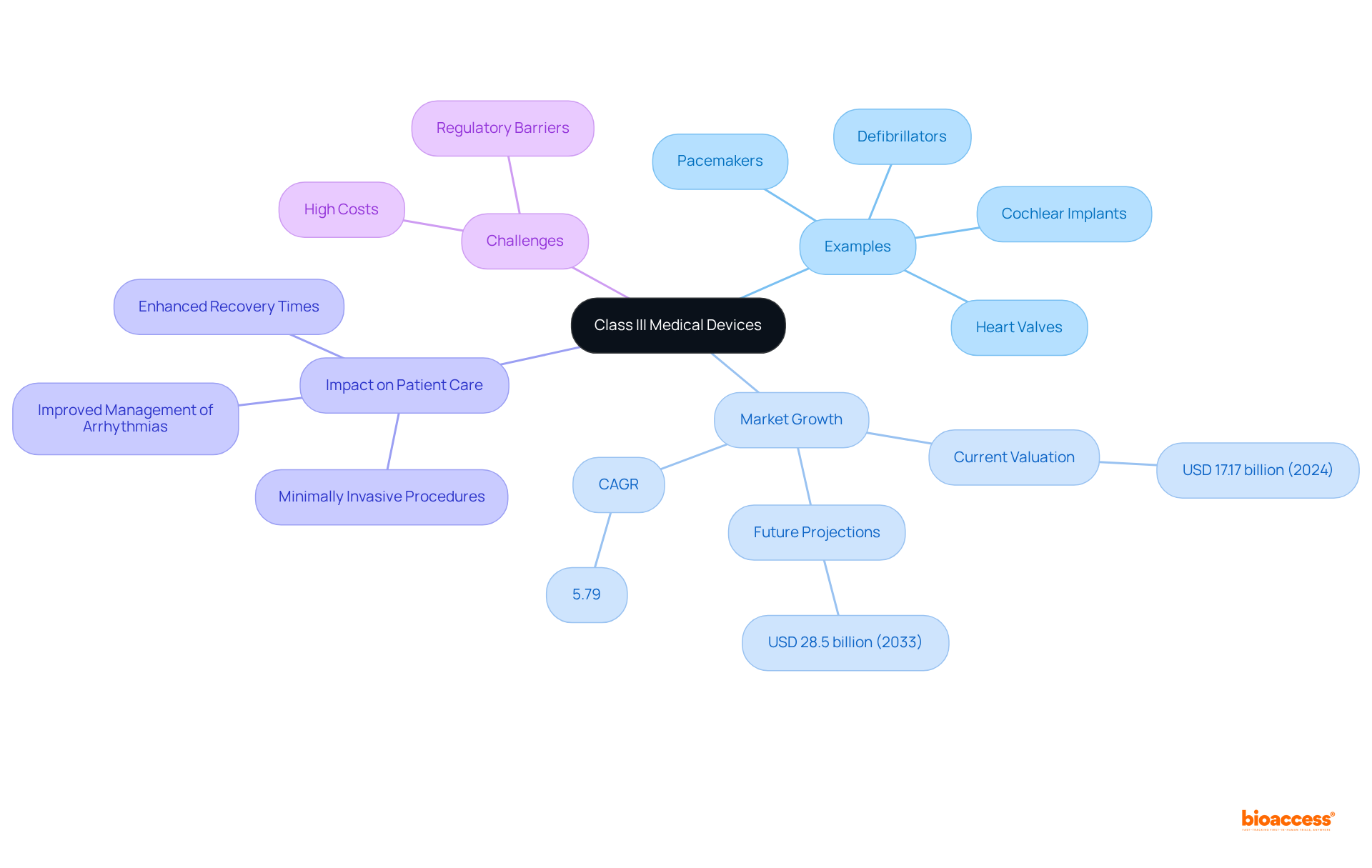
Post-market monitoring represents a critical regulatory obligation for Class III instruments, ensuring their ongoing safety and efficacy following market launch. Manufacturers must conduct regular monitoring, report adverse events, and implement necessary corrective actions. This continuous oversight is vital not only for preserving public confidence but also for guaranteeing that equipment performs as intended throughout its entire lifespan. Notably, an estimated 454,383 emergency department visits in the U.S. were associated with adverse incidents from healthcare instruments over a 12-month period, underscoring the importance of diligent oversight. Regulatory authorities emphasize that effective post-market surveillance can significantly mitigate risks and enhance patient safety, establishing it as an indispensable component of healthcare product management.
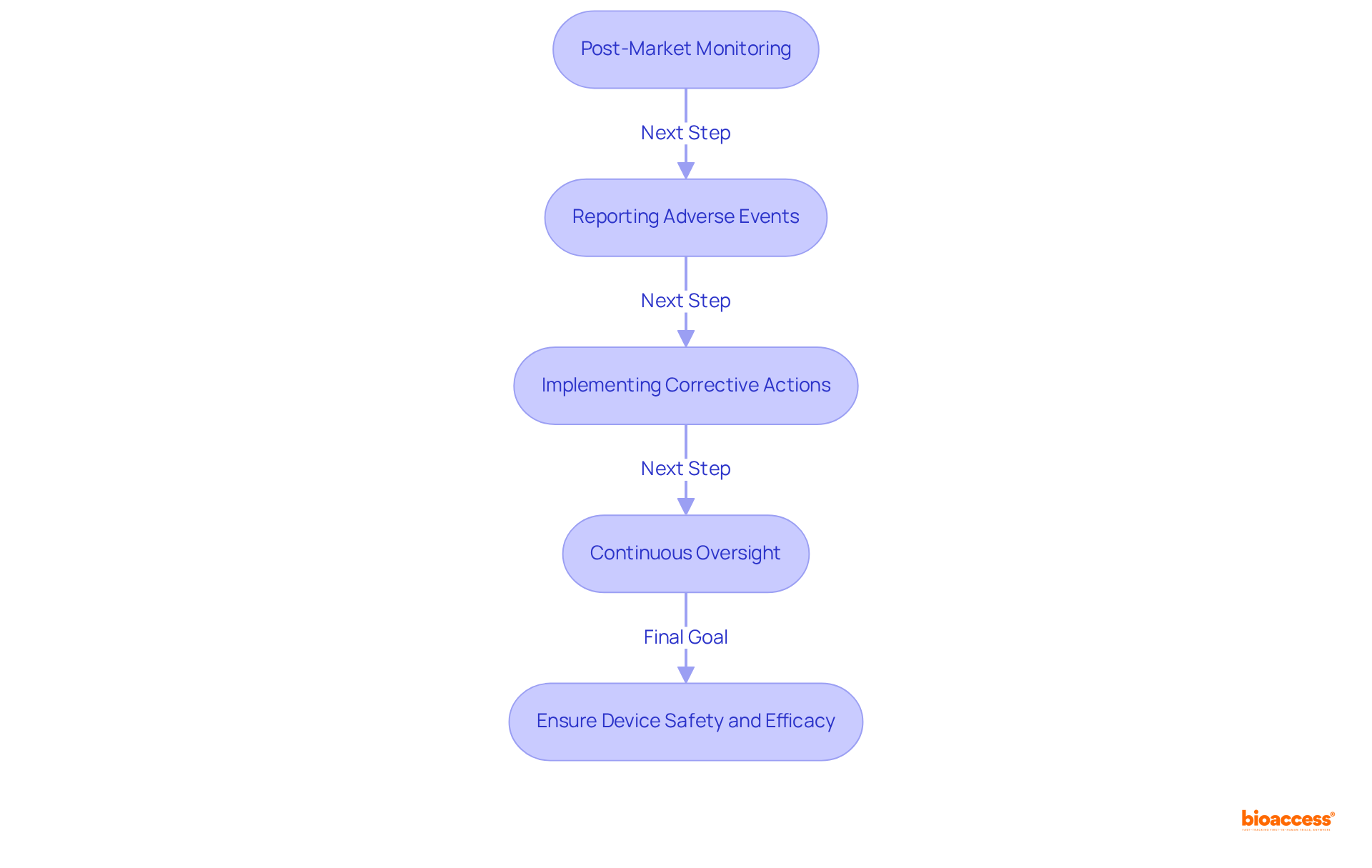
Clinical trials are essential for the advancement of medical device class 3 products, as they provide the critical proof of safety and effectiveness required for Premarket Approval (PMA) submissions. These trials include several phases, such as early feasibility studies and pivotal trials, which evaluate the performance of the apparatus in real-world scenarios. Specifically, pivotal trials are designed to demonstrate the apparatus's effectiveness and safety, often involving larger patient populations to gather substantial data.
Recent trends indicate that the success rate for Phase III trials in healthcare equipment research is approximately 58.3%, a significant improvement that challenges previous assumptions of low progression rates. Furthermore, the overall probability of success (POS) for drug development programs stands at 13.8%, underscoring the necessity of strategic planning and execution in clinical trials. Notably, only 1 in 10,000 compounds that begin in preclinical research reach the market, highlighting the challenges inherent in the clinical trial process.
The median durations for clinical trials are:
Additionally, around 50%-60% of drugs that enter Phase 3 trials, considered as medical device class 3, ultimately secure FDA approval, emphasizing the critical nature of successful pivotal trials. The information gathered during these trials not only influences regulatory approval but also significantly impacts patient care, ensuring that only the safest and most effective products are available in the market.
As the landscape of health-related trials evolves, the integration of advanced technologies and collaborative research methods is expected to enhance trial efficiency and success rates, ultimately benefiting both developers and patients.
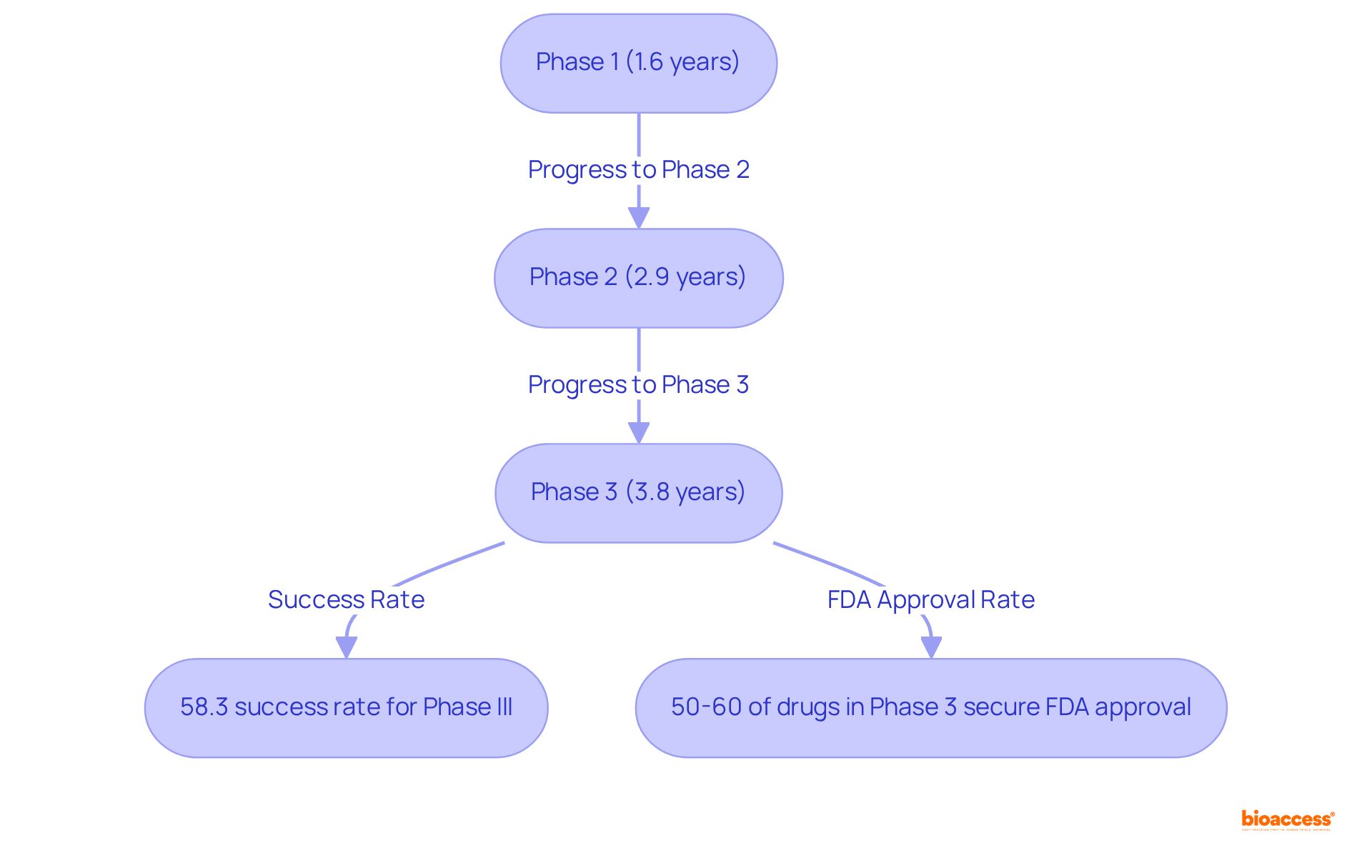
Producing medical device class 3 products requires navigating a landscape filled with challenges, particularly regarding strict regulatory adherence and quality management. Manufacturers must comply with complex regulations that can significantly impact their operational costs. For instance, the Premarket Approval (PMA) procedure for medical device class 3 instruments may take between 6 to 12 months or more, depending on complexity, necessitating extensive clinical trial data and documentation. This lengthy process often inflates development costs, with regulatory compliance consuming up to 25% of total manufacturing expenses, as noted by industry experts.
Real-world examples underscore the consequences of non-compliance. Inadequate clinical evidence or poorly designed studies can lead to submission rejections or delays, as evidenced by cases where manufacturers faced significant setbacks due to incomplete documentation. Furthermore, the potential for recalls due to compliance failures presents a substantial risk, complicating the manufacturing landscape even further.
Industry leaders highlight the importance of a proactive approach to regulatory compliance. Engaging with regulatory bodies early in the development process can clarify expectations and streamline submissions, ultimately reducing time to market. As one specialist pointed out, "Comprehending your apparatus's classification and choosing the appropriate pathway can assist you in sidestepping typical delays and hastening market entry."
Moreover, the integration of advanced technologies, such as AI and machine learning, is becoming increasingly vital in optimizing compliance processes. These technologies can enhance predictive modeling and data analysis, enabling manufacturers to identify potential compliance issues before they escalate. As the healthcare equipment industry evolves, maintaining strict quality control and adherence will remain essential for success in the medical device class 3 category.
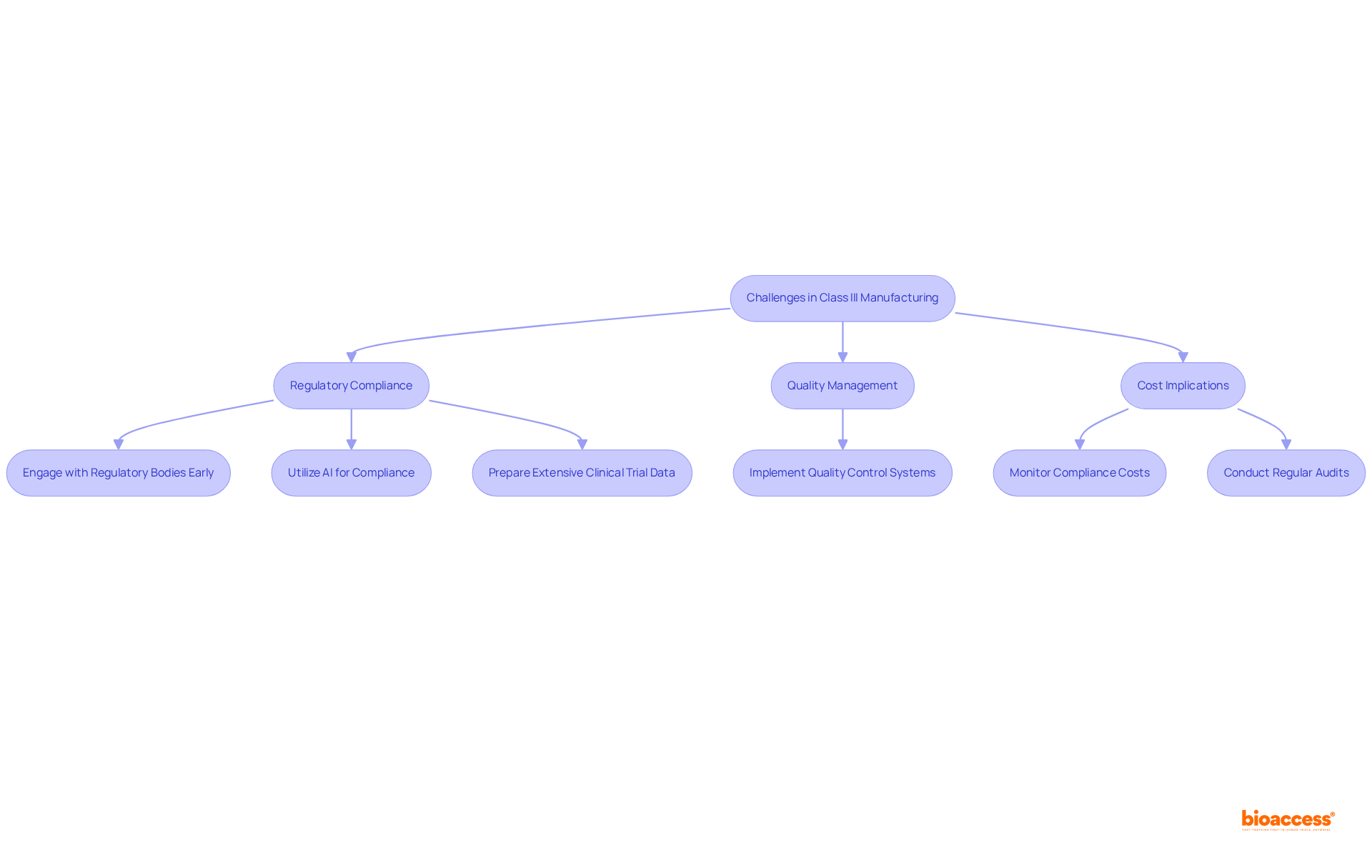
Technological progress is fundamentally transforming medical device class 3 healthcare instruments. Innovations in artificial intelligence, robotics, and advanced materials are greatly enhancing functionality and patient outcomes. AI integration facilitates precise diagnostics and predictive maintenance, while robotics improves surgical techniques and minimizes recovery times. For instance, AI algorithms are aiding in early disease detection through advanced imaging analysis, showcasing their real-world application in enhancing patient care. However, the dynamic nature of AI algorithms presents unique challenges in regulatory approval, necessitating clear guidelines on transparency and explainability to ensure compliance.
As the healthcare equipment industry continues to evolve, it is marked by an anticipated market growth to roughly $678.88 billion by 2025, expanding at a CAGR of 6%. Staying updated about these advancements is crucial for producers aiming to retain a competitive advantage. Embracing these technologies not only streamlines compliance with regulatory standards but also fosters innovation that can lead to personalized treatment options, ultimately improving healthcare delivery.
bioaccess® plays a vital role in enabling the swift progress of these healthcare instruments, connecting innovative firms with the possibilities of carrying out clinical research studies. The collaboration is essential as it addresses key challenges in the Medtech landscape, ensuring that the advancements translate into tangible benefits for patient care.
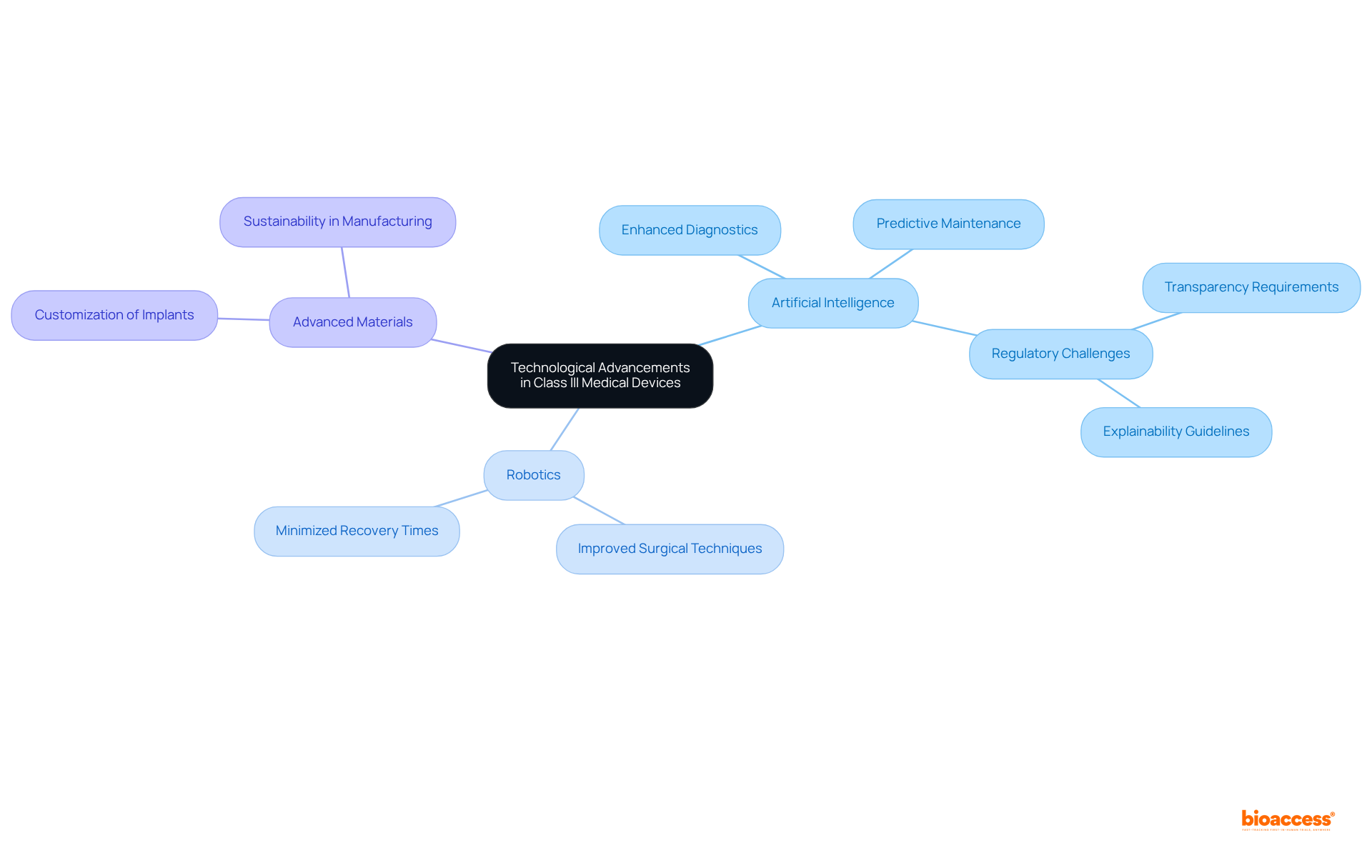
A thorough comprehension of Category III health instruments is essential for healthcare stakeholders, including producers, regulators, and healthcare providers. Knowledge of regulatory requirements, clinical trial procedures, and post-market responsibilities enables stakeholders to make informed choices that significantly impact patient safety and product efficacy.
Medical device class 3 products represent approximately 10% of all medical instruments overseen by the FDA, highlighting their significance in the market. The Premarket Approval (PMA) process, recognized as the most rigorous pathway for FDA approval, presents substantial challenges for manufacturers, necessitating comprehensive regulatory knowledge.
Furthermore, the Unique Identification (UDI) system plays a vital role in ensuring traceability and monitoring of these products, further emphasizing the significance of adherence. As noted by experts, the regulatory landscape is complex, and the impact of regulatory knowledge extends beyond compliance; it directly affects healthcare outcomes.
For instance, Juan Espinoza, MD, highlights that the innovation gap between pediatric and adult equipment is multifactorial, stressing the necessity for robust regulatory frameworks to ensure safety and effectiveness. In an evolving medical technology landscape, staying informed about Class III devices is crucial for advancing healthcare outcomes and ensuring that innovations translate into improved patient care.
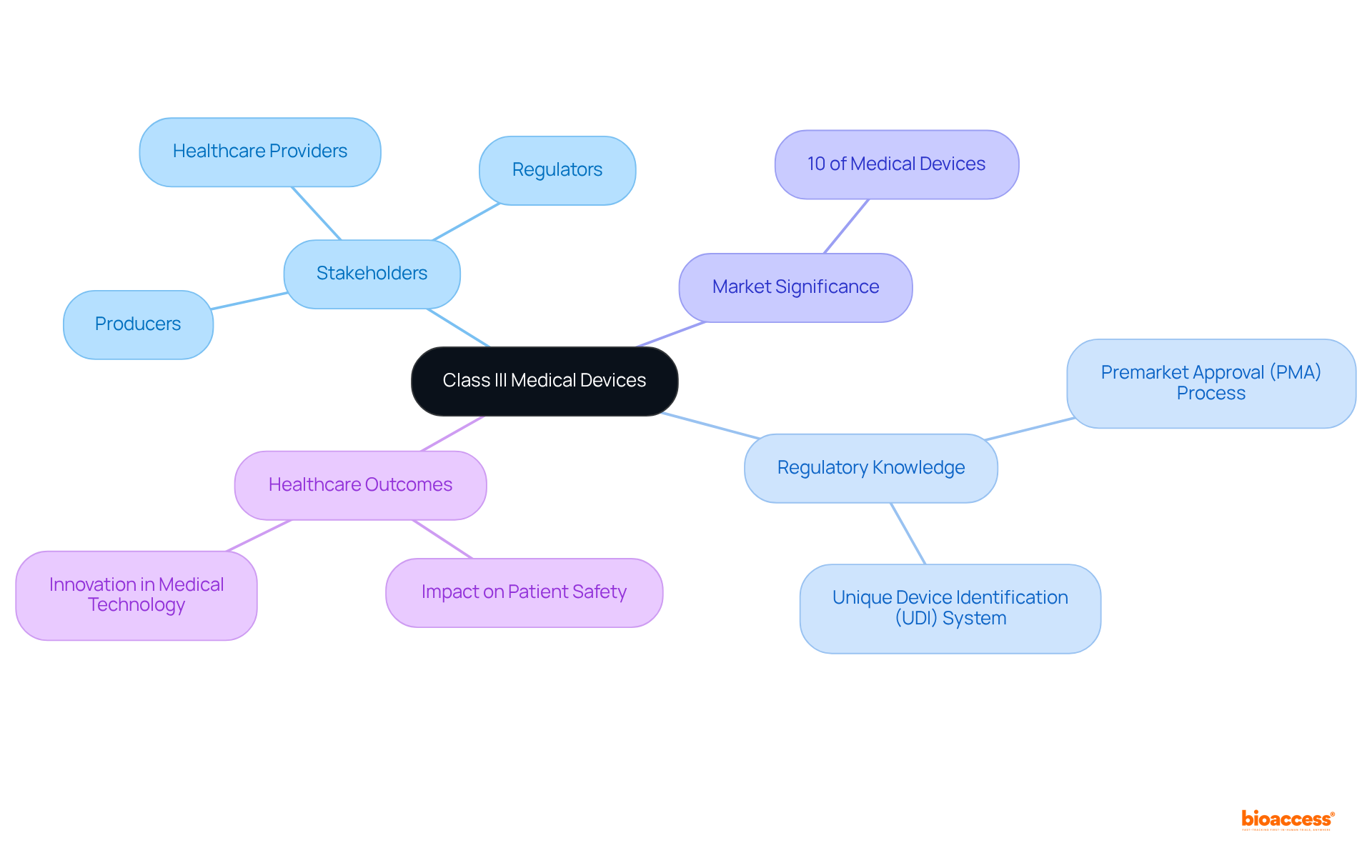
Understanding the complexities surrounding Class III medical devices is essential for stakeholders in the healthcare sector. These high-risk instruments are governed by stringent regulatory frameworks, particularly the Premarket Approval (PMA) process, which demands comprehensive clinical data to ensure safety and efficacy. The collaboration between innovative firms and organizations like bioaccess® plays a pivotal role in accelerating clinical research, effectively navigating these intricate regulations, and ultimately enhancing patient care.
Key insights from the discussion emphasize the critical importance of:
The challenges faced in manufacturing and compliance can significantly impact the development timeline and costs associated with Class III devices. Moreover, technological advancements are shaping the future of these medical instruments, presenting both opportunities and challenges that stakeholders must strategically address to maintain a competitive edge.
In conclusion, the significance of understanding Class III medical devices cannot be overstated. As the landscape of healthcare technology continues to evolve, stakeholders must remain informed about current trends and regulatory requirements to ensure that innovations translate into improved patient outcomes. Engaging with these insights and fostering collaboration within the industry will be crucial in overcoming challenges and advancing the safety and effectiveness of medical devices in the market.
What is bioaccess® and what role does it play in clinical research for Class III medical devices?
bioaccess® specializes in early-phase clinical studies for Class III medical devices, utilizing its regulatory agility and diverse patient populations in regions like Latin America, the Balkans, and Australia. It enables ethical approvals in 4-6 weeks, significantly faster than the average FDA 510(k) decision time, and helps Medtech innovators achieve enrollment rates that are 50% faster than traditional markets.
Why are Class III medical devices subject to stringent regulatory requirements?
Class III medical devices are subject to stringent regulatory requirements due to their potential risks to patients. Manufacturers must comply with the FDA's Premarket Approval (PMA) process, which requires comprehensive clinical data demonstrating both safety and efficacy.
What are the costs associated with the PMA process for Class III medical devices?
The average expenditure for PMA applications is approximately $94 million, which is significantly higher than the $31 million required for the less stringent 510(k) process.
What are the key steps in the Premarket Approval (PMA) process for Class III medical devices?
The key steps in the PMA process include conducting preclinical studies to establish safety data, designing and executing clinical trials to gather efficacy data, compiling a detailed PMA application, and submitting the PMA to the FDA for review.
What is the average review time for PMA applications, and how does it compare to the FDA's target?
The average review time for PMA applications historically exceeds the FDA's target of six months, averaging 432 days as of 2013.
What are Investigational Device Exemptions (IDEs) and why are they important for Class III medical devices?
Investigational Device Exemptions (IDEs) are crucial for Class III medical devices as they allow for the collection of clinical data necessary for PMA submissions, facilitating the approval process.
How do success rates for clinical trials of Class III medical devices vary?
Success rates for clinical trials of Class III medical devices can vary significantly. For example, oncology trials have historically had a low success rate of around 3.4%, highlighting the challenges in this high-risk category.
What impact does PMA approval have on legal standards for medical devices?
Medical devices that receive PMA approval benefit from a legal standard known as preemption, which limits lawsuits associated with these devices, while those approved via the 510(k) process face more exposure to legal actions.
What are the implications of the regulatory complexities for manufacturers of Class III medical devices?
Manufacturers must navigate complex regulatory requirements and consider strategic factors, such as the potential for legal exposure and the costs associated with the PMA process, when deciding on their regulatory route.